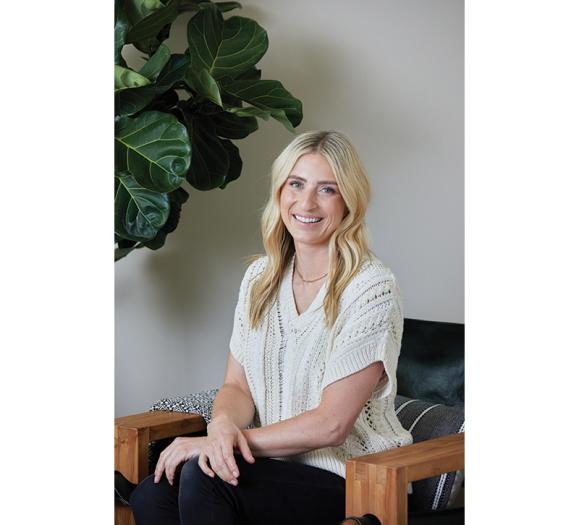The bathroom is a space with many functions, from grooming to relaxing, but bathroom lighting design is often treated as an afterthought. Here, Randall Whitehead, IALD, offers seven must-know tips to keep in mind for the best lighting for bathrooms during your next design project or the next time a customer walks into your showroom with a lighting design question.
1. Lighting at the bathroom mirror is critical

Should you place bathroom lights over the mirror? “This is where you see yourself for the first time every morning. I want the bathroom lighting to be as complementary as possible. It elevates my mood for the rest of the day. Having lighting on either side of the mirror is of major importance. It gives you even illumination and shadowless light for your face. Placing bathroom lights over the mirror only highlights your forehead, creating dark shadows under your eyes, nose and chin. Do not do that to yourself or your clients.”
2. Side lighting is key for bathroom lighting
“It is important to have side lighting, aka cross illumination, in all the bathrooms. Your guests will love it, even though they may not realize why they look so good. I would like to get 1,100 lumens (the equivalent of a 75W incandescent bulb) from each light fixture in the master bath and in the guest baths, because real work is being done here: makeup, shaving and spackling. The powder rooms only need 800 lumens (the equivalent of a 60W incandescent bulb) per fixture because guests are just going in there to fix their hair and see if there is anything stuck in their teeth.”
3. Task lighting is primary
“I like to think of the bathroom as a private sanctuary. This is where you can lock the door and stay in there for half an hour or more without being disturbed. You want to add layers of light (task, ambient, accent and decorative) as you would in other rooms, but the task lighting here is primary. The only other room where it is primary is the kitchen.”
4. Pay attention to color temperature
“Color temperature plays an important role. Daylight is 5000° Kelvin, incandescent light at full brightness is 2700° Kelvin and dimmed incandescent is 2400° Kelvin. When applying makeup and getting dressed you want to match the color of light in which you will be seen. If you’re getting dressed for work, then put yourself in a cooler temperature (4000-5000° Kelvin). If you are going out in the evening, then use a warmer color temperature (2400-2700° Kelvin). There are LED fixtures and illuminated vanity mirrors that have warm-dim capabilities, allowing you to adjust light between 5000° Kelvin and 2200° Kelvin (the color of candlelight). This gives you all the flexibility that you need, color temperature-wise. There are now magnifying mirrors available that have this technology as well.”
5. The best bathroom lighting balances function and style

“I want a spa-like atmosphere, at least in the master bath. If you make the guest bathroom too luxe then your guests will never leave. I like to incorporate decorative wall-mounted fixtures or ceiling fixtures that cast patterns of light on the walls and ceilings. I want indirect light that bounces the soft illumination off the ceiling. I want toe kick lighting, tucked under the vanity, so that I can slip into the bathroom in the middle of the night, without having to turn on the overhead lights. And as long as I have great illumination at the mirror with the flexible color temperature, then I am happy.”
6. Pendants come with key considerations — but they work

“I am seeing a trend towards installing hanging fixtures over the freestanding tubs in the more luxurious bathrooms. Code-wise, they should hang no lower than 7 feet 6 inches above the high water line. This is to ensure people do not touch the light fixture while standing in water.
I do like the idea of a pair of pendants either flanking a mirror or floating in front of a mirror at the sink. They should be mounted so that the shade is 5 feet 6 inches above the finish floor, putting it at eye level. The outer edge of the shade should hang about 3 inches away from the face of the mirror.
If you’re going to do a pendant or chandelier in the center of the room, then consider one that casts a shadow pattern to add some texture and visual interest to the bathroom.”
7. Emphasize that good bathroom lighting is essential
“The designer should let their clients know what is important to create bathroom lighting which is both task oriented and alluring at the same time. Lighting is visceral. It is hard for people to visualize the best lighting for bathrooms, when you simply talk about it or show it in pictures. I have set up my home as an ever-changing lighting lab. I take potential clients through and let them experience both good and bad lighting. The reaction is immediate if they can actually experience it. Luckily, I am seeing more and more lighting showrooms creating vignettes for bathrooms, especially vanity lighting. They have cross illumination (wall-mounted sconces, pendant fixtures or illuminated mirrors), a single fixture above the mirror, and a recessed fixture over the sink; each of these on separate switches so people can see how they look in the mirror with these three options. It is a game changer.”







